
Introduction
Foodborne illnesses, equipment breakdowns, and other environmental hazards are often the reasons for physical contamination. Physical contamination can pose a significant risk to a range of sectors, including healthcare, food production, cosmetics, and pharmaceuticals. This article will explore the key concepts of physical contamination, its sources, potential risks, and best practices for prevention.
Defining Physical Contamination
Physical contamination refers to the presence of foreign objects like glass, metal, hair, insect parts, or other contaminants in products or environments. Physical contamination can occur at any stage of production, manufacturing, or storage, and it can result in various hazards and risks. The contaminants themselves can pose a significant risk to consumers’ health and cause extensive damage to properties and equipment. Distinguishing physical contamination and other forms of contamination such as biological, chemical, or radiation contamination is essential since the mitigation strategies and prevention measures are distinct.
Common Sources of Physical Contamination
Physical contamination sources are more common than people may think and can originate from many sources. Sometimes it can be as simple as a strand of hair, staples, or even insects finding their way into products and environments. Some common sources of physical contamination are:
- Human Error
- Animal Intrusion (rodent, birds, insects, reptiles)
- Equipment or part Malfunction
- Quality Control Issues
- Processing errors
- Accidental introduction of foreign objects
These sources can pose a significant risk to products, production, and employees. Glass in food products can break teeth and cause severe internal damage, while a screw in machinery can cause significant damage to the equipment and halt production. Proper measures must be in place to prevent these hazards.
The Dangers of Physical Contamination
The dangers of physical contamination can range from the mild annoyance of discovering a hair in your food to life-threatening injuries or illnesses that can result from consuming contaminated products or operating contaminated equipment. In addition to the health hazards, physical contamination can cause significant financial loss in terms of destroyed products, property damage, lawsuits, and more. Preventing physical contamination is vital to avoid costly recalls, legal penalties, and reputational damage that can result from failure to prevent it.
Examples of Physical Contaminants
Physical contaminants can be present in various forms, including:
- Pieces of glass or other sharp objects
- Dirt and small rocks
- Hair or pieces of skin
- Bandages or other medical items
- Insects or other living organisms
- Metal shards or filings
These are just a few examples of physical contaminants that can pose a significant risk to products and environments. These types of contaminants can cause harm in many ways, including choking, lacerations, and choking, to name a few. It’s essential to understand the potential risks that physical contaminants can pose and to avoid them at all costs.
Mitigation Strategies and Best Practices to Prevent Physical Contamination
Preventing physical contamination requires sound best practices, including:
- Proper Hygiene: Wash hands, wear protective clothing, and follow safety protocols during the preparation, handling, and storage of products.
- Maintain and Inspect Equipment: Regular inspections of machinery and equipment can help detect malfunctions that can introduce physical contaminants into production processes.
- Proper Storage and Sanitation: Proper storage and sanitation protocols can prevent rodents, insects, and other external contaminants from entering products and environments.
- Quality Control Testing: Robust quality control testing can help detect physical contaminants that are not visible to the naked eye.
Implementing these practices can help prevent physical contamination and reduce the potential risks and hazards. It’s essential to establish robust prevention measures and protocols to avoid costly and dangerous contamination events.
Legal and Regulatory Landscape Surrounding Physical Contamination
In many industries, regulations and laws exist specifically to address physical contamination. However, these regulations can vary, depending on the industry, the state, and the country. There can be legal and financial penalties, including recalls, lawsuits, and fines, resulting from failure to prevent physical contamination. Proper employee education, robust prevention measures, and careful attention to best practices and regulations can help minimize the legal and financial risks associated with physical contamination.
Case Studies on Notable Incidents of Physical Contamination
Several high-profile cases demonstrate the disastrous effects of physical contamination. In 2018, millions of pounds of ground beef were recalled due to potential contamination with plastics and metal from a popular brand. The consequences of recalls are not only potentially fatal for consumers but can also be financially disastrous for companies. Another notable case is the well-documented incidents of insects and rodent droppings in fast-food restaurants. These kinds of cases can lead to loss of revenue, closure and negatively impact brand reputation.
The lesson from these events is that prevention is critical and cannot be overlooked. Robust prevention and mitigation protocols can help avoid these incidents and safeguard consumers and companies alike.
Conclusion
Physical contamination of products and environments can have far-reaching consequences for individuals, businesses, and communities. Understanding the sources and dangers of physical contamination, as well as how to prevent it, is crucial. Implementing sound best practices and promoting employee education can mitigate the risks of physical contamination and improve overall safety. It’s essential to maintain proper prevention measures, comply with regulations and follow robust quality control to avoid costly and dangerous physical contamination incidences.




